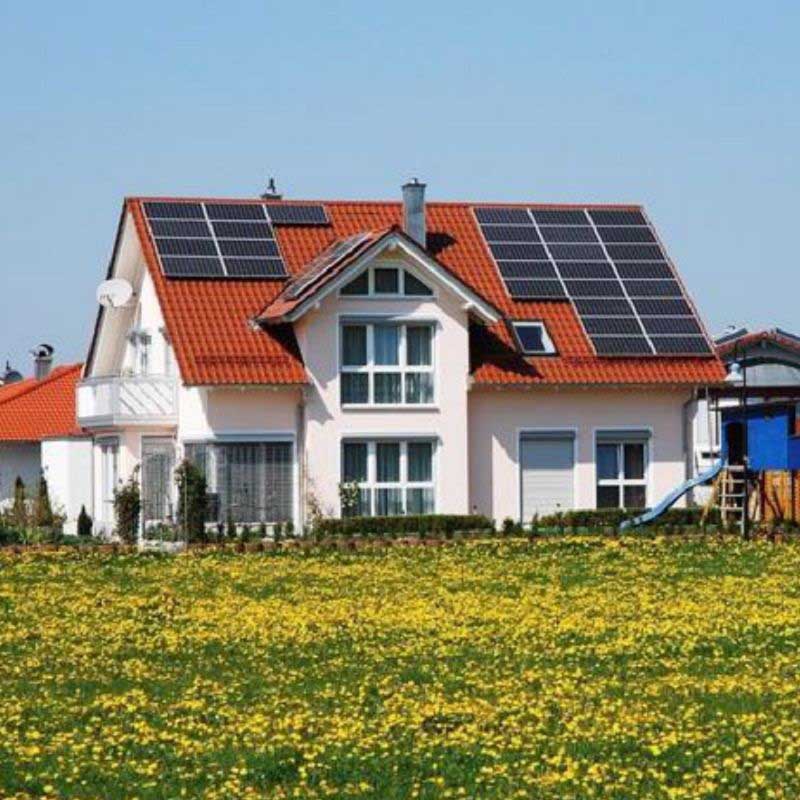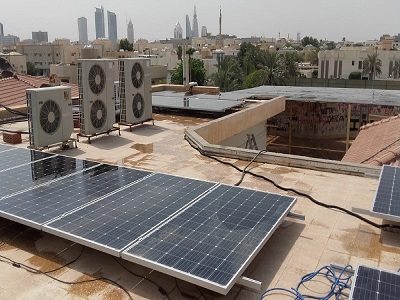Features and advantages of roof-mounted solar photovoltaic generation system
 Xianghong
Xianghong  August 16,2024
August 16,2024
Roof solar systems are generally more beautiful. Because the roof slope is large, rainwater is easy to drain, and the construction is simple and easy to maintain. In rainy areas, this type of roof is generally adopted. Therefore, it is suitable for installing a photovoltaic power generation system. The effect of building integration is obvious, and it can also be waterproof and heat-insulated. Today we will talk about the characteristics and advantages of installing a solar photovoltaic power generation system on a sloping roof.
1. The fixed photovoltaic support power generation system is generally suitable for household residential or commercial building roof power generation projects. For detached houses, a low-power grid-connected type is generally adopted, that is, the residents design a small power station of a corresponding scale according to the size of the roof; for community-style commercial houses, distributed installation, and centralized grid-connected type can be adopted.
2. Photovoltaic power generation systems developed by industrial and commercial users using roof resources such as factories and public buildings. The scale of this type of power station is limited by the effective roof area, and the installed capacity is generally several kilowatts to tens of megawatts; the power generation of the power station is encouraged to be consumed locally, and directly fed into the low-voltage distribution network or the medium and high voltage power grid of 35kV and below; the orientation, inclination and The shadow occlusion situation is diverse. This type of power station is the main form of distributed photovoltaic applications.
3. Photovoltaic support system for sloping roofs The sloping roof photovoltaic support system is reasonably designed for different roof structures and tile shapes. It is suitable for various types of tile roofs such as Roman tiles, fish scale tiles, and slate tiles, and can install solar cells of any size. plate. Great flexibility in the design and planning of commercial or residential rooftop solar systems. It is applied to parallel installation of framed solar panels on sloping roofs, such as iron roofs, glazed tile roofs, etc.
4. Advantages of photovoltaic system power stations on sloping roofs The biggest advantage of installing photovoltaic power stations on sloping roofs is that the building integration effect is obvious, that is to say, it fits well with the roof without affecting the aesthetics of the house at all, and it can also make the roof high-tech. There is no need to increase the height and calculate the inclination angle to install the roof photovoltaic support on the sloped roof.

Classification of photovoltaic power plants
At present, photovoltaic power plants can be roughly divided into three categories: off-grid photovoltaic power generation systems, photovoltaic grid-connected power generation systems, and hybrid systems.
1. Off-grid photovoltaic power generation system
Off-grid photovoltaic power generation system is a common way of solar energy application, also known as independent photovoltaic power generation system. As the name implies, the off-grid photovoltaic power generation system is not connected to the grid and has an independent energy storage system. The electrical energy obtained by the photovoltaic array from sunlight will be stored in the battery pack to ensure the continuity of the electrical energy supply. It is suitable for construction in some areas without electricity far away from the public grid.
Off-grid photovoltaic power generation systems are widely used in remote mountainous areas, areas without electricity, islands, communication base stations, and street lights.
2. Photovoltaic grid-connected power generation system
The photovoltaic grid-connected power generation system is connected to the traditional grid, and the grid is used as the energy storage unit of the system. When there is sunshine, the photovoltaic panel converts the solar energy into direct current, and converts it into alternating current through the inverter, which can be directly supplied to the load. . At the same time, the system will also input the excess electricity generated into the grid and provide it to other users when needed. When there is no sunlight, all load electricity is supplied by the grid. Photovoltaic grid-connected power generation systems can realize resource sharing under the premise of ensuring their own power demand and meeting people's demand for clean, green, and sustainable energy.
Photovoltaic grid-connected power generation systems are mainly concentrated in developed areas with relatively tight power consumption and remote areas with unstable public power grids. application.
3. Hybrid system
A hybrid system is a photovoltaic power station between the above two. It increases the backup generator set, and when the solar energy cannot meet the demand, the backup generator set provides power to the AC load, and at the same time converts the AC power generated by the backup generator set into DC power through rectification, and then sends it to the energy storage unit for charging to ensure Reliability of standby generator sets.
Composition of photovoltaic power plants
Photovoltaic power plants have different operating modes, but their basic principles are the same. The components are also generally composed of four parts: photovoltaic arrays, battery packs, controllers, and inverters. Different photovoltaic power plant systems contain different auxiliary facilities.
1. Photovoltaic array
Photovoltaic arrays are made on the principle of the photoelectric effect and are energy conversion components that can directly convert solar energy into electrical energy. Photovoltaic cell components can be obtained by assembling photovoltaic cells, and photovoltaic cell components can be assembled into photovoltaic arrays. In this process, in order to obtain as much energy support as possible, the design of the photovoltaic array is extremely important.
2. Battery pack
The role of the battery pack is equivalent to battery "storage", which can store the electrical energy generated by the photovoltaic array, and supply stable DC power to the load when needed, so as to ensure the normal operation of the electrical equipment. It is an independent and reliable power supply that can provide continuous power supply for the DC system and ensure that the electrical equipment is always in a stable voltage state.
3. Controller
The photovoltaic controller is an automatic control device used to manage photovoltaic arrays. It can control multiple photovoltaic arrays to charge battery packs or provide loads to solar inverters simultaneously to maximize energy utilization. In addition, the photovoltaic controller also has the function of serial communication data transmission, which can centrally manage and remotely control multiple photovoltaic system substations to improve the reliability and stability of the system.
4. Inverter
An inverter is a device used to convert DC power into stable AC power. It realizes the conversion of direct current to alternating current through components such as inverter bridge, control logic, and filter circuit.
In a word, a photovoltaic power station is a kind of future clean energy with great potential, and its operation mode and composition structure are constantly developing and innovating. Different types of photovoltaic power plants have different application scenarios and can play an increasingly important role in the future energy system.














